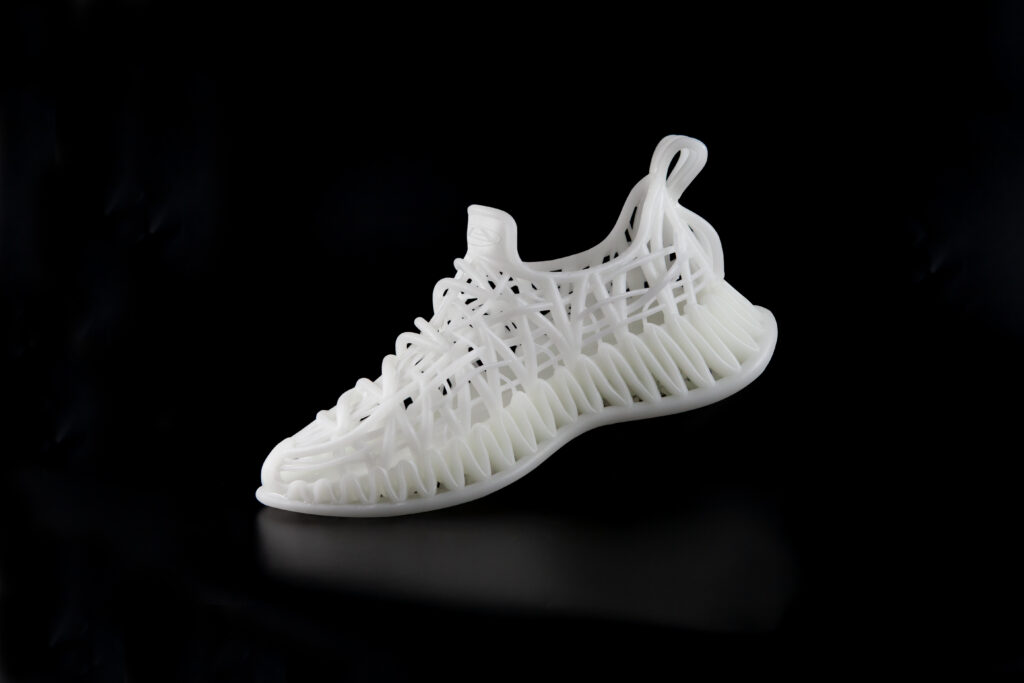Italian firm DWS has been known for its stylish stereolithography (SLA) systems. With its focus on the dental market, the company offers ceramic-filled and dental-specific resins and workflows, including the innovative DFAB 3D printer, which allows users to 3D print gradient-colored dental restorations. However, when I was at the 2023 Additive Manufacturing Strategies (AMS) summit, I was amazed at the durability and appearance of the TPU-like materials from DWS. I’d never seen the company’s Flexa thermoelastic materials up close and they really made me think of a number of new possible applications for the technology.
Flexa Digital TPU was developed for testing, prototyping, and final use in the fashion, luxury goods, shoe and apparel industries. It is also being used for parts such as gaskets and industrial components. The material family has good surface quality, accuracy and resolution, coupled with elasticity and flexibility (Shore A 75). With elongation of 237 percent, it’s also hard to break—I tried. Available in white, grey, black and orange (crepe) variants, Flexa Digital TPU is meant for DWS’s XPRO line of printers and the 029XC.
About the material, DWS Business Unit Manager Massimo Petrilli told me, “Both in soles and gaskets, the material is used for end-use parts (after having undergone adequate after-treatments). Customers use FLEXA Digital TPU for: shoes, soles, midsoles, gaskets, silent blocks, soft-touch details, including automotive ones and casings.”

I’m already familiar with some flexible materials, but love that there are an increasing number of options in flexible SLA. Some firms have focused on sporting goods, which I think is a fantastic application, but, generally, fashion is an area that is somewhat ignored. Out of the limelight, fashion details and luxury goods components is an incredibly fast growing segment for additive manufacturing. Many leather bags, high-end jewelry, and fashion goods are now made with 3D printed detailing, molds, or intermediates. The jewelry segment alone is predicted to reach nearly $1 billion, according to the “3D Printing Jewelry Markets 2023: Market Study and Forecast” report from SmarTech Analysis. Some tend to overlook the segment because the firms in it are so secretive and rarely disclose what they’re up to. While everyone is talking about shoe soles, I think that more attention has to be paid to fashion and luxury goods.
The idea of 3D printed detail and high touch elements is also something some in the industry don’t often discuss or think about. With 3D printing, it’s possible to add specific custom tactile elements to such high-end goods as a concept car or a haute couture dress. Similar to soft-touch paint or coatings, these can add value to items and increase their utility. Tactile cues, and area that I’m fascinated with, could point to the best place to hold a bottle or imbue it a more luxurious effect.
Gaskets are now seen as a bit of a commodity, but they’re used on all manner of very high-end machinery. With supply chains under siege and devices being made in ever-shorter production runs, 3D printed gaskets are not just prototypes anymore. Not only might short runs of gaskets aid in time-to-market, but they could feature specific geometries that offer definite advantages. Better textures on gaskets might help fit and prevent leakage, while lead times can be reduced for very specific gaskets. We can also now think of going to production with prototypes in high-mix, low-volume applications.
Used on automobiles and industrial machinery, silentblocks is also something that many have never even thought about. Either a type of a bushing or synonym for bushing, depending on where you’re from, a silentblock is an elastomeric component that can eliminate noise, vibration, shocks, and extend machine life and performance. Not only can they be 3D printed, but they are actually sorely missing on a lot of 3D printers, as well. They keep certain components and vibrations from negatively affecting the performance of the rest of the machine or production plant.
These are just a handful of ideas that have already been or could be explored with materials like Flexa Digital TPU from DWS, but they really are just the tip of the iceberg. Particularly because this is a somewhat new material family from DWS, I’m sure we’ve only just scratched the surface of what’s possible.
Subscribe to Our Email Newsletter
Stay up-to-date on all the latest news from the 3D printing industry and receive information and offers from third party vendors.
Print Services
Upload your 3D Models and get them printed quickly and efficiently.
You May Also Like
The Market and Industry Potential of Multi-Material 3D and 4D Printing in Additive Electronics
Additive manufacturing leverages computer-based software to create components for products by depositing either dielectric or conductive materials, layer by layer, into different geometric shapes. Since its birth in the 1980s,...
3DPOD 262: Bio-inspired Design for AM with Dhruv Bhate, Arizona State University
Dhruv Bhate is an associate professor at Arizona State University. There, he looks at structures, materials, and design. Previously, he worked at PADT as well as in the semiconductor and...
3DPOD 261: Tooling and Cooling for AM with Jason Murphy, NXC MFG
Jason Murphy´s NXC MFG (Next Chapter Manufacturing) is not a generalist service; instead, the company specializes in making tooling. Using LPBF and binder jet, the company produces some of the...
3DPOD 260: John Hart on VulcanForms, MIT, Desktop Metal and More
John Hart is a Professor at MIT; he´s also the director of the Laboratory for Manufacturing and Productivity as well as the director of the Center for Advanced Production Technologies....


































